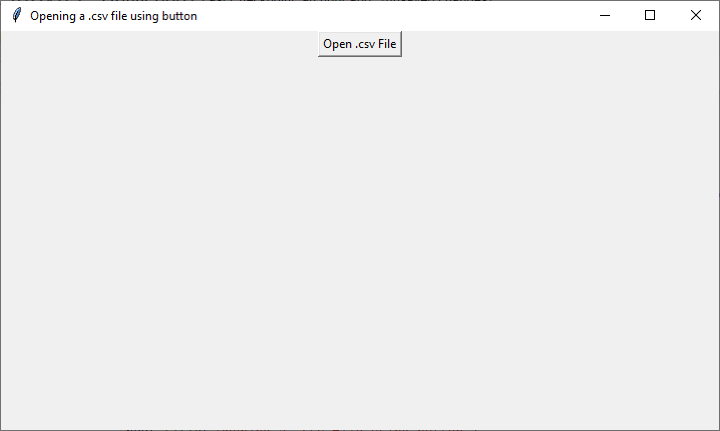
 Data Structure
Data Structure Networking
Networking RDBMS
RDBMS Operating System
Operating System Java
Java MS Excel
MS Excel iOS
iOS HTML
HTML CSS
CSS Android
Android Python
Python C Programming
C Programming C++
C++ C#
C# MongoDB
MongoDB MySQL
MySQL Javascript
Javascript PHP
PHP
- Selected Reading
- UPSC IAS Exams Notes
- Developer's Best Practices
- Questions and Answers
- Effective Resume Writing
- HR Interview Questions
- Computer Glossary
- Who is Who
How to make a button open a specific .csv file using Python Tkinter?
Graphical User Interfaces (GUIs) make it easy to use computer programs. Python, a popular programming language, has a tool called Tkinter that helps create these GUIs. In this article, we'll explore the process of making a button open a specific .csv file using Python and Tkinter, creating a practical application that enables users to interact with data in a user-friendly manner.
Designing the Application
Before we dive into the implementation details, let's outline the design of the application. Our goal is to create a simple Tkinter-based program with the following components
A Tkinter Window The main window of the application, which provides the user interface.
A Button A button that, when clicked, opens a specific .csv file.
.csv File Selection When the button is clicked, a file dialog should appear, allowing the user to select a .csv file.
File Handling The selected .csv file should be opened, and its contents should be accessible for further processing or display.
With the application's design in mind, let's see the step-by-step instructions with corresponding code for Python example that creates an application that opens a specific .csv file using Python Tkinter
Step 1: Import the Necessary Modules
To begin, import the required modules for our implementation: tkinter.
The first step is to import the necessary modules, including Tkinter for creating the GUI, the filedialog module for opening file dialogs, and the csv module for reading and processing .csv files.
# import the tkinter module for GUI import tkinter as tk from tkinter import filedialog import csv
Step 2: Create a Function to Open the .csv File
Next, create a function that opens the .csv file when the button is clicked. This function will use the filedialog module to open a file dialog, allowing the user to select the desired .csv file. If a file is selected, it will be opened, and its contents processed.
# Function to open a specific .csv file
def open_csv_file():
file_path = filedialog.askopenfilename(defaultextension=".csv", filetypes=[("CSV Files", "*.csv")])
if file_path:
try:
with open(file_path, "r") as csv_file:
# Read and display the CSV file's contents
csv_reader = csv.reader(csv_file)
for row in csv_reader:
print(row)
except Exception as e:
print(f"Error: {e}")
Step 3: Create a Tkinter Window and Button
Now, create a Tkinter window, set its title, and create a button that triggers the open_csv_file() function when clicked.
# Create a Tkinter window
root = tk.Tk()
root.geometry("720x400")
root.title("Opening a .csv file using button")
# Create a button to open the .csv file
open_button = tk.Button(root, text="Open .csv File", command=open_csv_file)
open_button.pack()
Step 4: Run the Tkinter Main Loop
Finally, start the Tkinter main loop to launch the application and allow users to interact with it.
# Start the Tkinter main loop to run the GUI application root.mainloop()
Let's explore the complete implementation code and output of this application.
Example
# import the tkinter module for GUI
import tkinter as tk
from tkinter import filedialog
import csv
# Function to open a specific .csv file
def open_csv_file():
file_path = filedialog.askopenfilename(defaultextension=".csv", filetypes=[("CSV Files", "*.csv")])
if file_path:
try:
with open(file_path, "r") as csv_file:
# Read and display the CSV file's contents
csv_reader = csv.reader(csv_file)
for row in csv_reader:
print(row)
except Exception as e:
print(f"Error: {e}")
# Create a Tkinter window
root = tk.Tk()
root.geometry("720x400")
root.title("Opening a .csv file using button")
# Create a button to open the .csv file
open_button = tk.Button(root, text="Open .csv File", command=open_csv_file)
open_button.pack()
# Start the Tkinter main loop to run the GUI application
root.mainloop()
Output
When you click the "Open .csv File" button, a file dialog will appear, allowing you to select a specific .csv file. Once selected, the contents of the .csv file will be displayed in the console as rows of data. This basic example provides a foundation that you can customize to suit your specific needs, such as processing, analyzing, or displaying the data from the .csv file within the Tkinter application.

Conclusion
In this article, we've explored the process of creating a Python Tkinter application that opens a specific .csv file when a button is clicked. The ability to interact with data through a user-friendly GUI is a valuable skill for developers, and Tkinter provides the tools to make it happen. Whether you're working on data analysis, reporting, or any application that involves working with data, the combination of Python and Tkinter can empower you to create efficient and user-friendly interfaces for your users.

